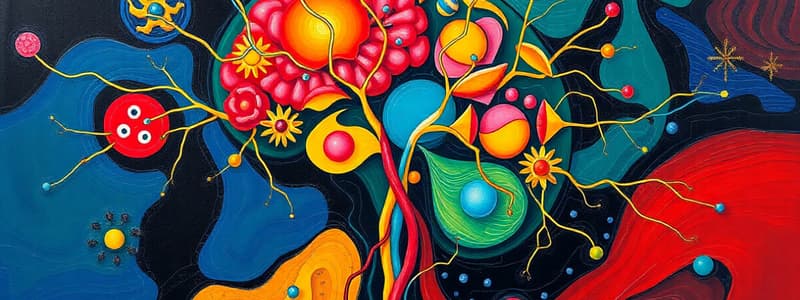Podcast
Questions and Answers
What are the three main steps of the Nervous System in processing information?
What are the three main steps of the Nervous System in processing information?
Gather information, process and integrate information, inform the body parts.
Name the two components of the Central Nervous System.
Name the two components of the Central Nervous System.
The brain and spinal cord.
What is the role of dendrites in a neuron?
What is the role of dendrites in a neuron?
Dendrites collect impulses from other neurons or sensory cells.
How do Schwann cells contribute to nerve impulse transmission?
How do Schwann cells contribute to nerve impulse transmission?
What factors determine the strength of the stimulus in nerve impulses?
What factors determine the strength of the stimulus in nerve impulses?
Describe the process of neurotransmitter release at a synapse.
Describe the process of neurotransmitter release at a synapse.
What effect do painkillers like aspirin have on pain receptors?
What effect do painkillers like aspirin have on pain receptors?
What happens to the neurotransmitter after it triggers an impulse in the post-synaptic neuron?
What happens to the neurotransmitter after it triggers an impulse in the post-synaptic neuron?
Flashcards are hidden until you start studying
Study Notes
Nervous System
- Gather information about surroundings: Sensory receptors collect data from the environment.
- Process and integrate information: The Central Nervous System (CNS) interprets and makes sense of the collected data.
- Inform parts of the body that need to be informed: The Peripheral Nervous System (PNS) sends signals to effectors, such as muscles or glands, to respond to the processed information.
Central Nervous System (CNS)
- Location: Brain and spinal cord.
Peripheral Nervous System (PNS)
- Components: Sensory receptors, sensory neurons, motor neurons, and end plates.
- Sensory receptors: Detect stimuli from the environment.
- Sensory neurons: Carry impulses from receptors to the CNS.
- Motor neurons: Carry impulses from the CNS to effectors.
- End plates: Junctions where motor neurons connect with muscle fibers.
Neurons
- Structure: Specialized cells that transmit nerve impulses.
- Dendrites: Receive impulses from other neurons or sensory cells.
- Cell body: Contains the nucleus and controls the cell's activities.
- Axon: Carries impulses away from the cell body.
- Myelin sheath: Insulating layer around the axon (produced by Schwann cells), speeding up impulse transmission.
- Presynaptic knobs: Increase contact with effectors.
Nerve impulse transmission
- All-or-none principle: An impulse is either triggered or not.
- Threshold: Minimum stimulus strength required to trigger an impulse.
- Impulse strength: The brain interprets strength based on the frequency of impulses arriving per second.
- Resetting: After an impulse, the neuron resets to be ready for the next one.
Synapses
- Definition: Junction between neurons.
- Transmission: Nerve impulse triggers the release of neurotransmitters (e.g., acetylcholine) from presynaptic knobs.
- Neurotransmitter function: Diffuses across the synapse, binds to receptors on the post-synaptic neuron, and triggers a new impulse.
- Deactivation: Neurotransmitter is broken down by enzymes (e.g., cholinesterase) to stop signal transmission.
Painkillers
- Prostaglandins: Chemicals released by damaged tissue, increasing pain sensitivity.
- Aspirin and ibuprofen: Inhibit prostaglandin synthesis, reducing pain.
Neuron Types
Sensory neurons
- Function: Transmit impulses from receptors to the CNS.
- Location: Dorsal root of the spinal cord.
- Cell body: Outside the CNS.
Motor neurons
- Function: Transmit impulses from the CNS to effectors.
- Location: Ventral root of the spinal cord.
- Cell body: Inside the CNS.
Interneurons
- Function: Connect sensory and motor neurons within the CNS.
- Location: Exclusively within the CNS.
- Cell body: Inside the CNS.
- Myelin sheath: No myelin sheath.
Studying That Suits You
Use AI to generate personalized quizzes and flashcards to suit your learning preferences.




